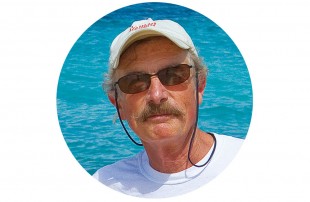Bold-sailor image will survive a bit of caution in race decisions

What would sailors do without foul weather?
Sailors spin yarns. By definition, yarns are sea stories enhanced by exaggeration, but sometimes the subject matter needs no hyperbole to be a gripping tale. Confrontations with the sea in its angriest moods can be such intensely graphic experiences that there is no need or even room for exaggeration.
Foul weather nurtures the lore of sailing and writes the stories we tell. The stories may be meant to entertain, but they are often told as expressions of pride: We have met the sea’s challenges, we are bold sailors.
The Rolex Fastnet Race last July yielded a rich trove of material for sea stories, but it also raised questions about how far the bold-sailor ethos should be carried.
The 695-mile race—from the Isle of Wight, around Fastnet rock in the Irish Sea and back to Cherbourg-en-Cotentin on the coast of France—is known for its often nasty sailing conditions. Brit sailors, a tough lot seasoned by the cold, wind-whipped, tide-ripped Atlantic waters in which they sail, are proud of that reputation and quite delighted to subject themselves to the Fastnet’s cruelties. This year, 430 boats entered the race.
The race officials of the Royal Ocean Racing Club, the race’s sponsoring organization, perhaps had protecting the Fastnet’s reputation as a classic test of sailors’ seamanship and fortitude in mind when they decided to start the race in spite of forecasts warning of particularly grim conditions. Weather models showed that the fleet would be sailing into a powerful low pressure system with winds in excess of 40 knots and conditions that produce extremely high seas.
These are some of the results of that decision:
A total of 166 boats withdrew from the race. Some of the men and women who sailed on those boats spoke in post-race interviews of a “terrifying night” and sailing in “survival mode.”
A number of sailors were injured, some seriously. Among those was a man who suffered a life-threatening head injury but could not be evacuated because conditions were too dangerous for a helicopter.
A 37-foot Jeanneau Sunfast, a doublehanded entry, sank 20 minutes after its crew transmitted a mayday alert. The two sailors survived in a liferaft until rescuers arrived.
Many boats reported structural damage and at least four were dismasted.
In addition to responses by His Majesty’s Coast Guard to 28 emergencies involving boats in the race, rescue teams from ports on the coast of England braved the dangerous sea conditions repeatedly to aid racers in distress.
The wicked sea state was the product of gale-force winds blowing against a powerful ebbing tide, resulting in steep waves that many in the racing fleet described as 20 to 25 feet high.
The racers who endured those conditions chose to be there, but the rescuers who were called out to save lives and boats had no choice. They were duty bound to go to the aid of people who were not at sea in the performance of some essential service to society, but in an amateur sporting contest.
The rescuers came from six lifeboat stations on the coast of England and made repeated forays into the maelstrom, including six by the Yarmouth station alone. All of the rescue team members were volunteers who serve in the Royal National Lifeboat Institution. Revered in a nation surrounded by the sea, the RNLI is not a government agency or a business, but rather a nonprofit organization (called a charity in the UK) funded entirely by donations.
The institution was founded in 1824, when its rescue craft were open double-ended lifeboats that were rowed to the rescue. Today, the lifeboats are motorboats ranging from RIBs to 50-foot self-righting vessels. The RNLI reckons it has saved 144,000 lives in its two centuries of service, while more than 600 of its volunteers lost their lives in rescue operations.
The demands made on rescue services by the 2023 Fastnet, particularly those involving lifeboat volunteers, beg the question: Was the possibility that rescue personnel would have to put their own safety at risk to save endangered race competitors considered in the decision to start the race when brutal sea conditions were forecast?
Postponing a yacht race that hundreds of boat owners have entered is not an easy decision. Besides being a major inconvenience for all concerned, it flies in the face of the conviction that sailors who compete in offshore races are expected to be qualified to deal with the challenges dealt by the sea, whatever they may be.
One of the founders of the Fastnet race in 1925, an English yachting journalist named Weston Martyr, expressed that belief eloquently when he wrote that yacht racing “is without question the very finest sport that a man can possibly engage in, for to play this game it is necessary to possess in the very highest degree those hallmarks of a true sportsman: skill, courage and endurance.”
Stirring words for sure, but as the scribe said, sailboat racing is a game, and when weather services predict it will likely be a dangerous one for the players as well as those called to tend to them when things go wrong, the start of the game should be delayed. The bold-sailor image will survive. There will still be sailing yarns to tell.
A few months after the Fastnet, in the French port of Le Havre, race officials postponed the start of a high-profile race across the Atlantic Ocean to Martinique. The Transat Jacques Vabre race has its own reputation as a grueling test of the highly skilled professional and amateur sailors who are its typical entrants. The 2023 fleet consisted of 95 ultrahigh performance boats—IMOCA 60s, Class 40s, Ocean Fifties and Ultim catamarans—all sailed doublehanded. The decision to delay the start was based on forecasts of potentially dangerous sea conditions caused by storm Ciarán. It was the right decision.

Comments